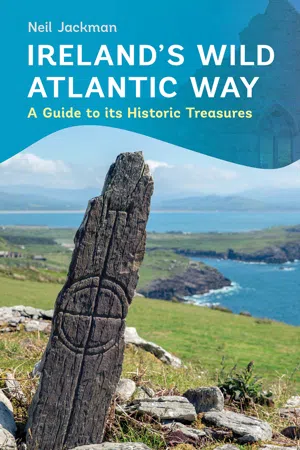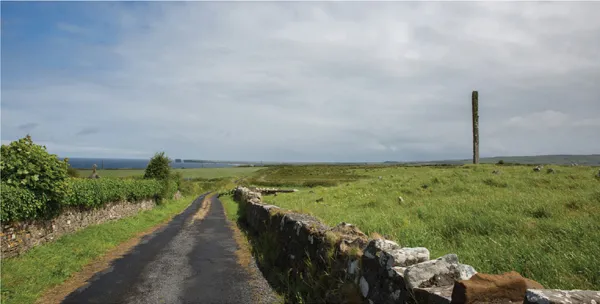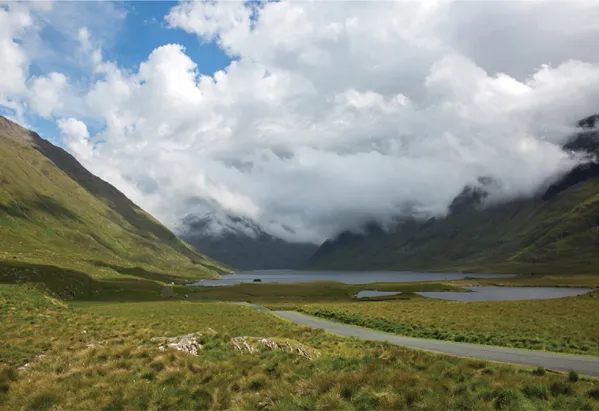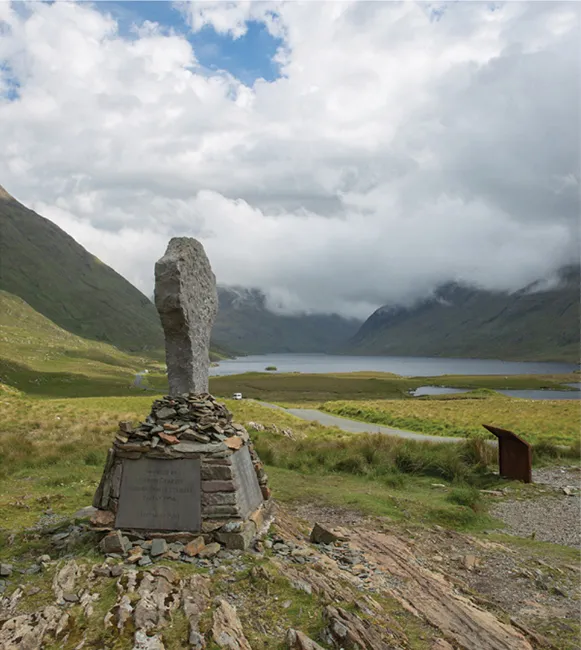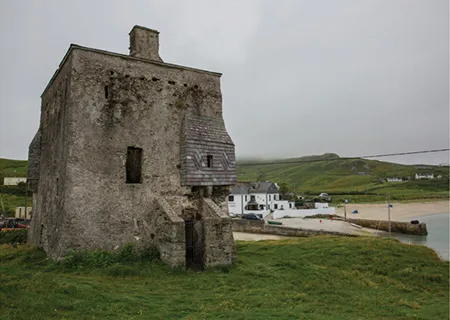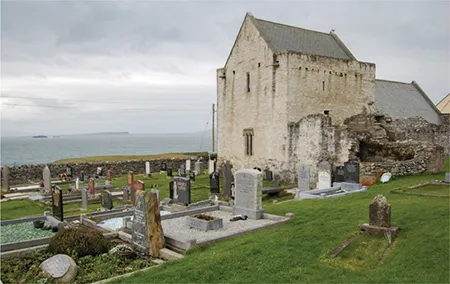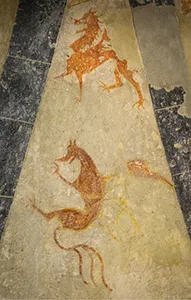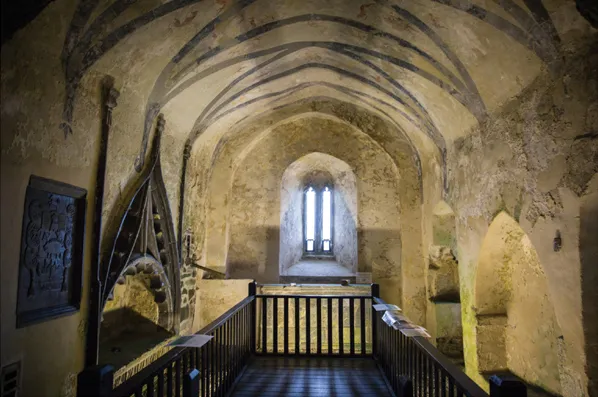![]()
MAYO
I have to admit to having a certain favourable bias towards Mayo, as I spent two very happy years living here when I worked as an archaeologist for the county council. The coast of County Mayo is truly beautiful and varied, from rugged cliffs, sheltered coves and deep bogs to the turquoise, almost tropical-looking, waters of Clew Bay abounding with islands set in the shadow of the holy mountain, Croagh Patrick.
There is always something fascinating around every bend in County Mayo
The charming town of Westport has become one of Ireland’s most popular places for a break, thanks to its wonderful music scene and hospitality.
However, the weather in Mayo can often be difficult to predict. You may well encounter the famous Mayo mist, especially on Achill Island. The mist wraps you in white, almost ethereal, drifting shrouds that, very thoroughly and evenly, drench you before you notice how hopelessly wet you are. Even on a fine day elsewhere, the weather on Achill and Clare Island does its own thing.
This is the land of Gráinne Ní Mháille, the Pirate Queen, whose deeds and actions have won her a place in history and legend. She commanded these waters, and we will visit a number of her strongholds and harbours. Further north along the coast at Céide you will discover a remarkable prehistoric landscape, and discover the story of how Ireland’s first farmers cleared enormous forests to start to change the landscape of Ireland forever.
57 | DOOLOUGH VALLEY
The scenic Doolough Valley
The beautiful Doolough Valley was the scene of one of the darkest tales in Irish history. The province of Connacht experienced the very worst of the Great Famine. In the decade between 1841 and 1851, census records show that the population of Connacht fell by well over 400,000 people. In just ten years nearly one third of the people of Connacht had either emigrated or perished. The rough and largely uncultivated land of County Mayo was especially ill prepared for the devastation of the Famine. Most of the people were employed in agriculture, particularly on small farms, and there was little industrialisation and few large towns. With such a dangerous set of circumstances, the repeated failure of the potato crop caused appalling devastation. Disease and cold winters carried away many of the people, who were weakened by poor nutrition. However, as harsh as the conditions were, they could not compete with the ignorant cruelty of uncompassionate men, who valued profit and their personal ease above the lives of the people.
The Famine Memorial at Doolough Valley
On 31 March 1849, it was a bitterly cold day in Louisburgh. Hundreds of starving people sought food and shelter in the Westport Workhouse. After expending much of their scant resources and energy to arrive in Louisburgh, they were informed that the relieving officer would not inspect them there; instead, they were ordered to walk to Delphi, a distance of nearly 20km (12 miles), to apply to the Board of Guardians. Heedless of the condition of the starving people, the relieving officer declared that if they did not arrive in Delphi at 7 a.m. the following morning they would be removed from the Relief List. A number died from exhaustion and exposure on that long cold march to Delphi through the mountain passes. Those who arrived for the appointed time had to endure a wait of more than five hours in the freezing weather as the Board of Guardians did not appear until noon, after they had enjoyed a pleasant lunch. They refused to help them and ordered them to return to Louisburgh. Now completely exhausted and battered by icy winds, rain, hail and snow, a number of the starving people collapsed and died on the road back through the Doolough Valley. The contemporary writer and storyteller James Berry described the path from Louisburgh to Delphi as being covered with corpses ‘as numerous as sheaves of corn in an autumn field’.
Coordinates: Lat. 53.666196, Long. -9.781367
Irish Grid Reference: L 82304 69948
Opening hours/entry fees: No opening hours or entry fees applied at the time of writing.
Directions: The simple stone cross marking the Doolough Valley Famine Memorial is situated north of Delphi on the R335.
Nearest town: Delphi (5km).
58 | CLARE ISLAND
Clare Island in Clew Bay possesses a brooding beauty. The history of the island is entwined with that of the O’Malley family, who were lords of Umhall (the lands around Clew Bay) for centuries. The earliest reference to the family comes from the Annals of the Four Masters, which recorded the slaying of ‘Donal and Murtough, two sons of Murray O’Malley … in Cliara’ in the year 1235. ‘Cliara’ was the ancient name for Clare Island. The O’Malleys were feared and respected as a seafaring power. The most famous member of the family is, of course, Gráinne Ní Mháille (or Granuaile), the ‘Pirate Queen’ who is the subject of many stories and legends (her story is featured in Rockfleet Castle, Site 64).
The tower house near the harbour was built by the O’Malleys in the sixteenth century. It stands three storeys high and it would once have had a pitched slate roof. The tower house was converted to a police barracks in the early nineteenth century. It was at this time that the decorative slate flashing was added to the defensive bartizans that protect the corners of the tower house. The positioning of the tower house ensured the sheltered harbour was well protected.
The tower house on Clare Island
The martial prowess of the O’Malleys was seen in 1588, when the Gran Grin, one of the largest ships in the Spanish Armada, was driven onto rocks off Clare Island. Of the 329 men on board, only around a hundred made it to the shore, where they were immediately captured by Eoghan Dowdarra Roe O’Malley (father of Granuaile). The men of Clare Island held the Spaniards, but when the captives tried to escape by stealing the islanders’ boats, the O’Malleys ruthlessly slaughtered them, killing 64, including their leader, Don Pedro de Mendoza.
Clare Island Abbey
Clare Island Abbey is thought to have originated in the middle of the thirteenth century, though it is said that the community of monks was driven off the island by pirates in 1224. The powerful Cistercian foundation at Abbeyknockmoy established a small cell on Clare Island, with a handful of monks to serve the local population.
Some of the wonderful medieval art that has been subject to a delicate conservation process
The interior of the abbey
The building that we see today is a small fifteenth-century Cistercian church, with a small nave and a two-storey chancel with domestic quarters for the monks above it. The ceiling of the chancel is a real treasure, as it is covered with beautiful and intricate paintings, which are some of the finest examples...
